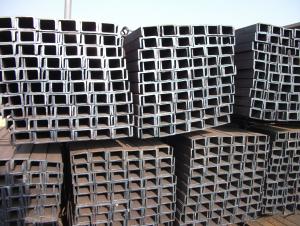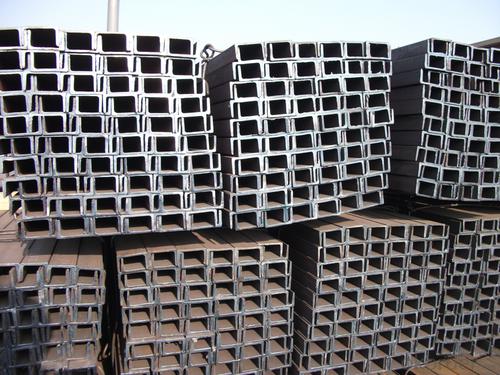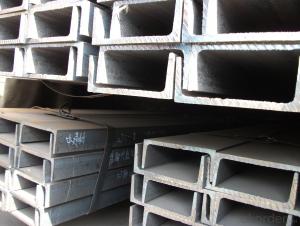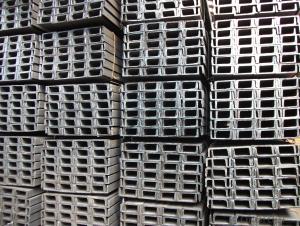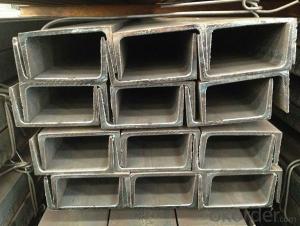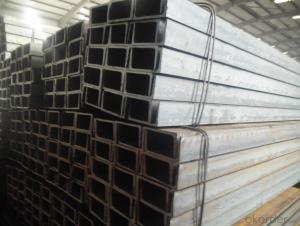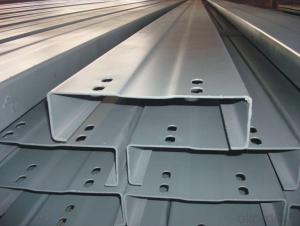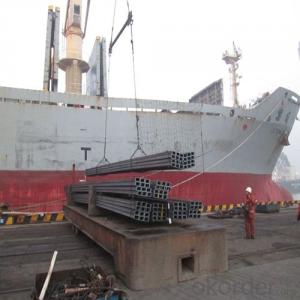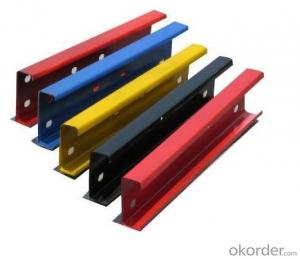U Channels JIS Standard Hot Rolled Steel U Channels SS400
- Loading Port:
- Tianjin
- Payment Terms:
- TT or LC
- Min Order Qty:
- 25 m.t.
- Supply Capability:
- 200000 m.t./month
OKorder Service Pledge
OKorder Financial Service
You Might Also Like
Product Description of U Channels JIS Standard Hot Rolled Steel U Channels SS400
JIS Standard Hot Rolled Steel U Channels SS400 Details:
Minimum Order Quantity: 25 Tons Unit: m.t. Loading Port: Xingang Port
Supply Ability: 1000 Tons Per Day Payment Terms: TT or L/C
Specifications of U Channels JIS Standard Hot Rolled Steel U Channels SS400
Standard Applied: GB Standard, EN Standard(UPN), JIS Standard
Sizes: 50mm to 300mm
Material Grade: Q235B, Q345B, S235JR, SS400, ASTM A36
As shown in the figure:
Usage/Application of U Channels JIS Standard Hot Rolled Steel U Channels SS400
The steel u channel can be applied to construction of warehouses, workshops, sport stadiums and car parks etc. In details, the steel u channel belongs to carbon structural steel which is applied to in the field of construction and machinery. The steel u channel is usually used for arch-itechtural structure, and they could be welded in order to support or hang a vari-ety of facilities. They are also usually used in combination with I beam. Generally,the steel u channel must possess perfect welding property, riveting property and mechanical property and so on.
Package & Delivery of U Channels JIS Standard Hot Rolled Steel U Channels SS400
The steel u channel will be packed in bundle with steel wire at each end of every bundle and color marking in order to help the customer to recognize his goods more easily at sight.
And steel u channel could be loaded into 20ft or 40ft container, or by bulk cargo. If the weight of each bundle reaches less than 3.5 mt, the loading by break bulk cargo should be choosed. When the weight of each bundle reaches less than 3mt, the loading by container should be choosed.
As for the transportaion from mill to loading port, the truck will be usually used. And the maximum quantity for each truck is 40mt.
All in all, we could do in accordance with customer's request
Images of U Channels JIS Standard Hot Rolled Steel U Channels SS400
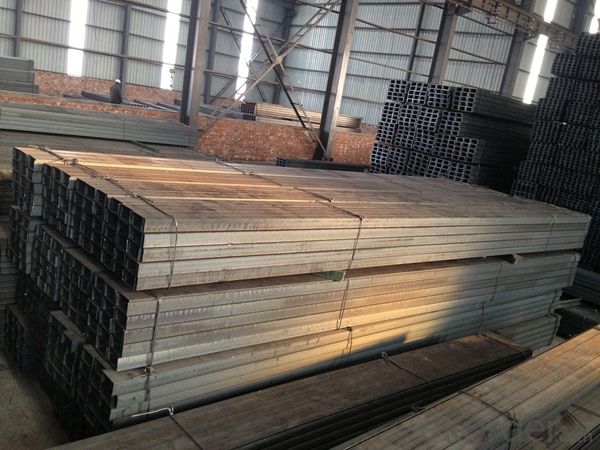
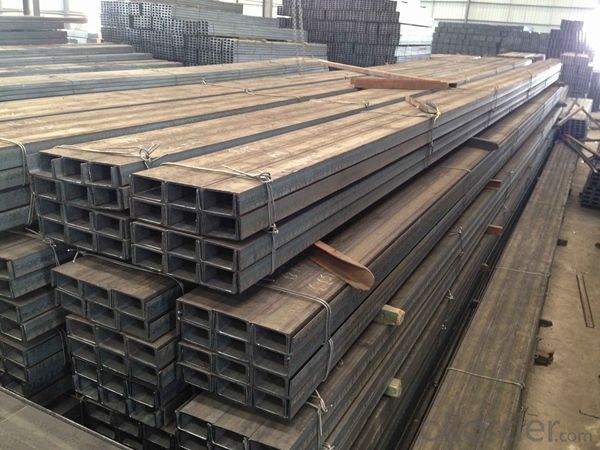
FAQ
Q1: Why buy Materials & Equipment from OKorder.com?
A1: All products offered byOKorder.com are carefully selected from China's most reliable manufacturing enterprises. Through its ISO certifications, OKorder.com adheres to the highest standards and a commitment to supply chain safety and customer satisfaction.
Q2: How do we guarantee the quality of our products?
A2: We have established an advanced quality management system which conducts strict quality tests at every step, from raw materials to the final product. At the same time, we provide extensive follow-up service assurances as required.
Q3: How soon can we receive the product after purchase?
A3: Within three days of placing an order, we will begin production. The specific shipping date is dependent upon international and government factors, but is typically 7 to 10 workdays.
- Q: How do steel channels contribute to structural stability?
- Steel channels contribute to structural stability in several ways. Firstly, they provide added strength and support to the structure. The shape of steel channels, with their wide base and narrow top, allows them to bear heavy loads and resist bending or twisting forces. This makes them ideal for use in beams, columns, and other structural members. Furthermore, steel channels can be used as reinforcement within concrete structures. When embedded in concrete, they enhance the overall strength and durability of the structure. Steel channels help distribute the load across a larger area, reducing stress concentrations and preventing localized failures. In addition, steel channels can be interconnected to form a framework, increasing the rigidity of the structure. By connecting steel channels in a network, they create a system that resists lateral forces such as wind or earthquakes. This helps maintain the stability of the structure and prevents it from collapsing or being damaged during extreme events. Moreover, steel channels are highly resistant to corrosion, which is essential for long-term structural stability. Unlike other materials, steel channels do not deteriorate easily when exposed to moisture, chemicals, or extreme temperatures. This durability ensures that the structural integrity of the building remains intact over time. Overall, steel channels play a vital role in enhancing the structural stability of buildings and other structures. Their strength, versatility, ability to reinforce concrete, and resistance to corrosion make them an indispensable component in construction.
- Q: Can steel channels be used for mezzanine guardrails?
- Mezzanine guardrails can indeed be constructed using steel channels. The strength and durability of steel channels make them a common choice for construction and industrial purposes. By utilizing steel channels, a robust and reliable barrier can be established for mezzanine guardrails, guaranteeing the safety of workers and averting accidents from elevated platforms. Moreover, steel channels can be readily tailored and effortlessly fitted to conform to precise design specifications, making them highly favored for mezzanine guardrail systems.
- Q: What are the different steel channel profiles available?
- There are several different steel channel profiles available, each with its unique characteristics and applications. Some of the commonly used steel channel profiles include C-channel, U-channel, Z-channel, and Hat-channel. C-channel, also known as American Standard Channel (ASC), is a versatile profile that is widely used in construction and structural applications. It has a straight web and flanges of equal length, forming a C-shaped cross-section. C-channels are often used for beams, columns, and purlins in building frames. They can also be used as a support for metal decking or as a base for overhead doors. U-channel, also known as a U-beam or American Standard Channel (ASC), has a U-shaped cross-section with flanges that are shorter than the web. U-channels are commonly used for applications requiring additional strength and stability, such as bracing, framework, and support structures. They are also used in the automotive industry for truck beds, trailers, and vehicle frames. Z-channel, also known as Zee or Zed, has a Z-shaped cross-section with two flanges and a web connecting them. Z-channels are often used in construction for applications where two pieces need to be joined together, such as wall studs, roof framing, and floor joists. They can also be used as a support for wall panels or cladding systems. Hat-channel, also known as furring channel, is a thin-gauge steel profile with a wide, flat top and two short, parallel legs. Hat-channels are commonly used as a support for drywall or other types of cladding materials in ceiling and wall applications. They provide a secure and stable base for attaching panels and can help improve soundproofing and insulation in buildings. These are just a few examples of the different steel channel profiles available in the market. The choice of profile depends on the specific application requirements, such as load-bearing capacity, structural stability, and compatibility with other building components. It is important to consult with a structural engineer or supplier to determine the most suitable steel channel profile for a particular project.
- Q: Are steel channels suitable for solar panel installations?
- Yes, steel channels are suitable for solar panel installations. Steel channels, also known as steel C-channels or U-channels, are commonly used as mounting structures for solar panels. They provide a strong and durable support system for the panels, ensuring their stability and longevity. Steel channels are preferred for solar panel installations due to their high strength-to-weight ratio, making them capable of withstanding various environmental conditions. They offer excellent resistance to corrosion, which is crucial for outdoor installations exposed to rain, snow, and humidity. Additionally, steel channels can be customized and fabricated to fit specific solar panel dimensions, allowing for easy and secure attachment. Moreover, steel channels are cost-effective compared to other mounting options, such as aluminum or stainless steel. They are readily available in the market and can be easily installed by professionals. The versatility of steel channels also makes them suitable for both ground-mounted and rooftop solar panel installations. In conclusion, steel channels are a reliable and suitable choice for solar panel installations. Their strength, durability, resistance to corrosion, cost-effectiveness, and ease of installation make them an ideal choice for supporting solar panels and ensuring their optimal performance.
- Q: Can steel channels be used for playground equipment?
- Yes, steel channels can be used for playground equipment. They are commonly used as structural elements in the construction of playground equipment due to their strength, durability, and ability to withstand heavy loads and rough play.
- Q: Are steel channels suitable for commercial construction projects?
- Yes, steel channels are suitable for commercial construction projects. They are widely used in the construction industry due to their high strength, durability, and versatility. Steel channels provide structural support, are resistant to fire and corrosion, and can be easily customized to meet specific project requirements. Additionally, steel channels offer cost-effective solutions for commercial construction, making them a popular choice among architects and builders.
- Q: What is the maximum length of steel channels?
- The length of steel channels can differ based on different factors, including the manufacturer's specifications, transportation restrictions, and practical considerations of handling and installation. Typically, standard lengths for steel channels range from 20 to 40 feet (6 to 12 meters). These lengths are commonly established by the manufacturing process and the equipment's capabilities for cutting and forming the channels. To ascertain the precise maximum length for a specific type of steel channel, it is essential to consult with the manufacturer or supplier.
- Q: How do steel channels contribute to the modular construction process?
- Steel channels are an essential component of the modular construction process as they provide structural support and stability to the modular units. These channels are typically made of high-quality steel, which offers excellent strength and durability. One way steel channels contribute to the modular construction process is by acting as a framework for the modular units. They are used to create the structural skeleton of the modules, ensuring that they can withstand the loads and stresses imposed on them during transportation and installation. The channels are precisely fabricated and assembled to form a rigid framework, allowing the modules to be easily transported and stacked together on-site. Additionally, steel channels enable the integration of various building systems within the modular units. They provide a secure base for the installation of electrical wiring, plumbing, and HVAC systems. By incorporating these channels into the design, the modules can be pre-wired and pre-plumbed, minimizing on-site labor and accelerating the overall construction process. Furthermore, steel channels offer flexibility and adaptability in the modular construction process. They can be easily modified or extended to accommodate changes or additions to the modular units. This allows for efficient customization and flexibility in design, enabling the modules to meet specific project requirements. In terms of sustainability, steel channels contribute to the eco-friendliness of modular construction. Steel is a highly recyclable material, and the use of steel channels in modular construction reduces waste and promotes resource efficiency. Additionally, the durability of steel channels ensures that the modular units have a long lifespan, reducing the need for frequent replacements and minimizing the environmental impact. Overall, steel channels play a crucial role in the modular construction process by providing structural support, facilitating the integration of building systems, offering flexibility in design, and promoting sustainability. Their contribution ultimately leads to faster construction timelines, improved quality, and cost-effectiveness in the modular construction industry.
- Q: #10 how to anchor the channel steel on the foundation, the anchor bars generally choose how much?
- This needs to be determined according to the force and the form of the structure, and can not be done at will.
- Q: How do steel channels contribute to the stability of a structure?
- Steel channels contribute to the stability of a structure in several ways. Firstly, they provide additional structural support by distributing the load evenly across the structure. The shape of the channel, with its flanges and web, helps to resist bending and twisting forces, preventing any potential collapse or deformation of the structure. Moreover, steel channels enhance the overall strength and rigidity of the structure. The high tensile strength of steel allows for the channels to bear heavy loads without buckling or warping. This added strength and rigidity help to maintain the structural integrity of the building, ensuring its stability during various external forces such as wind, earthquakes, or heavy loads. Steel channels also contribute to the stability of a structure by providing a stable base or foundation. They can be used as beams or columns to support the weight of the structure and transfer the load to the foundation. In this way, steel channels act as a strong and reliable support system, preventing any excessive movement or settlement of the structure. Additionally, steel channels offer versatility in design and construction. They can be easily fabricated into various shapes and sizes to suit the specific needs of the structure. This flexibility allows for efficient and cost-effective construction methods, ensuring stability without compromising on design aesthetics or functionality. In conclusion, steel channels play a vital role in ensuring the stability of a structure. By providing additional support, enhancing strength and rigidity, acting as a stable base, and offering design versatility, steel channels contribute to the overall stability and integrity of a building, making it safe and reliable for its intended purpose.
Send your message to us
U Channels JIS Standard Hot Rolled Steel U Channels SS400
- Loading Port:
- Tianjin
- Payment Terms:
- TT or LC
- Min Order Qty:
- 25 m.t.
- Supply Capability:
- 200000 m.t./month
OKorder Service Pledge
OKorder Financial Service
Similar products
Hot products
Hot Searches
Related keywords
